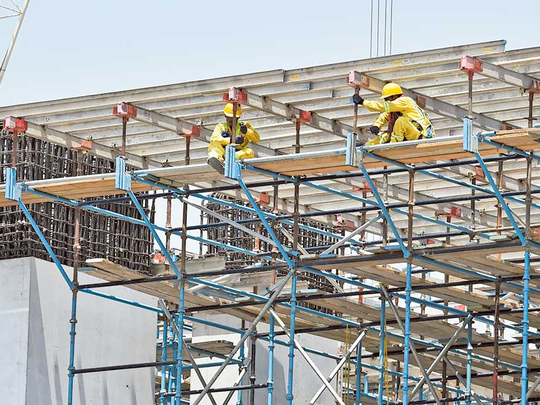
Dubai: The Gulf’s construction and real estate sectors could face a problem of plenty if the economies do not get back into high growth mode soon, according to the consultancy A.T. Kearney.
“The value of projects already in the construction stage as of March 2016 is four times the value of all projects completed in the previous 10 years,” according to the report. “And another 10 years’ worth of projects is in the pipeline at earlier stages of development.
“Each year between 2016 and 2020, this pipeline would deliver anywhere between seven and 12 times the real estate value delivered yearly between 2007 and 2009.”
As of December last, $2 trillion (Dh7.34 trillion) of construction projects were in the GCC pipeline, accounting for almost 70 per cent of all construction in 2016 and 2017.
That’s the good part. The negative comes in when Gulf states’ economic numbers are put up. Average GDP growth between now and 2020 will average only 3.2 per cent, based on World Bank estimates.
This is “far below the region’s scorching 8 per cent growth before 2008,” the report states.
Dubai’s projects’ outlay has a solid base to them, given that the city will be hosting the Expo 2020 at the turn of the decade. And on the residential supply side, developers are hoping that enough new investors and end users will come in and start snapping up units.
But the same conditions need not apply for other Gulf states’ plans.
While population growth remains positive, there are forecasts that expect it to “slide to just a third of pre-crisis levels, at 2.9 per cent over the next five years”.
“We believe the GCC’s real estate sector has entered a perfect storm of trends that could imperil its success — overcapacity looms on an unprecedented scale,” the A.T. Kearney report says.
(Since 2006, the value of cancelled projects in the Gulf has been worth almost twice the value of completed projects; in other words, a project only has a 35 per cent chance of completion after plans are announced.)
What does all this mean for Gulf investors looking to commit funds on real estate assets? Should they be searching for options outside of the region or keep the funds within? Or chase some other asset class altogether?
|
|
Federico Mariscotti |
Courtesy: A.T. Kearney |
According to Federico Mariscotti, vice-president at A.T. Kearney, the solution is not to stick to any one location.
“I think it’s healthy that investors should be of two minds over what to do with their funds … if anything what worries me is an unswerving resolve to invest in one location,” Mariscotti said. “That’s how bubbles grow.
“And this year Gulf investors have plenty more and better options than last year: Prime locations in London at a favourable price level, more competitive price levels in the GCC, strong dollar across the board.
“I do not see a marked difference in attractiveness along the regional/global axis, it’s more about the stability of the region you invest in: Political, economic, exposure to currency fluctuations.”
If overcapacity is seen as a longer term concern, there is another one looming in the short-term — how Dubai/Gulf developers plan to finance their projects, The report points out that growth in banking loans in the Gulf over the next three years is forecast to drop by a third (based on estimates by Fitch Ratings Agency).
“Direct investment in the region has already slowed by 30 per cent over the past three years, according to the United Nations Conference on Trade and Development, and is expected to remain at this level as long as geopolitical uncertainty and low oil prices persist,” the report adds.
“With increasingly finite financial resources and signals of diminishing demand, developers have little choice but to improve how they manage their expanding project portfolios.
“There’s now an overall geopolitical volatility that could change material availability and costs quite quickly. So it’s key to weatherproof your business against price movements, like using price hedging of commodities with futures contracts, and deploying new approaches to gathering market intelligence.
“One such thing is web-crawling, an early-warning system which uses advanced analytics to find patterns of information scattered across the web, and identify early on what will eventually affect your value chain in a few months. We believe agility is key, while cost compression has little further to offer, in terms of a winning differentiation.
Gulf developers need to reset their project strategy
Real estate developers cannot keep playing by the same rule book going forward. According to the new report put together by A.T. Kearney, they must bring in change in how they structure their projects.
The three areas where they can bring about immediate change is:
1. Extend the scope of a tender from one project to several projects — staggered in a rigorous time sequence. For instance, have three projects that would last four to six years. This will create the ecosystem.
2. Select participating partners based on their proven potential for innovation and collaboration. Other industries thrive on this concept, from the partnerships between aircraft and jet-engine manufacturers to automotive companies with global value chains that select suppliers. There are many proven practices — the goal is to explore and choose the most appropriate.
3. Design a completely new set of incentives to guide a new behaviour This requires an alignment on the part of all partners to optimise the time and cost of the overall project (rather than during each stage). This will encourage value creation.












